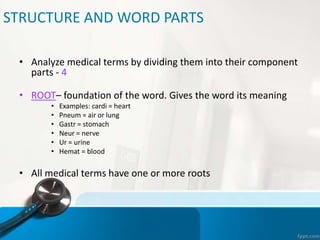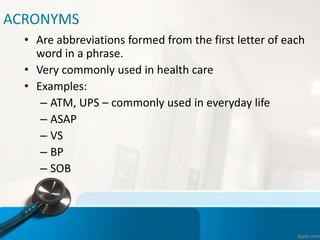Chapter 1 medical terminology
- 2. INTRODUCTION Word Parts Combining Parts to Form Words/Rules Pronunciation Abbreviations, Symbols and Acronyms
- 3. ORIGINS OF MEDICAL LANGUAGE ŌĆó Ancient Greeks and Romans ŌĆō Hippocrates ŌĆō Father of Western Medicine ŌĆó Roman Empire ŌĆō Latin ŌĆó German, French, English terms ŌĆó Now 90% of terms are of Greek and Latin origin.
- 4. STRUCTURE AND WORD PARTS ŌĆó Analyze medical terms by dividing them into their component parts - 4 ŌĆó ROOTŌĆō foundation of the word. Gives the word its meaning ŌĆó Examples: cardi = heart ŌĆó Pneum = air or lung ŌĆó Gastr = stomach ŌĆó Neur = nerve ŌĆó Ur = urine ŌĆó Hemat = blood ŌĆó All medical terms have one or more roots
- 5. WORD PARTS (conŌĆÖt) ŌĆó COMBINING FORMS ŌĆō Combination of the root and the combining vowel ŌĆō most commonly ŌĆśOŌĆÖ May also be an ŌĆśIŌĆÖ ŌĆó Links root to suffix or root to another root ŌĆó Makes word easier to pronounce and spell. ŌĆó Written as root/o ŌĆó Examples: ŌĆō Gastr/o ŌĆō Pneum/o ŌĆō Hemat/o ŌĆō Path/o = disease
- 6. WORD PARTS (con ŌĆśt) ŌĆó SUFFIXES ŌĆō Word Endings ŌĆō Adds information or modifies root ŌĆō Examples: ŌĆō Logy = study of ┬╗ Cardiology = study of the heart ŌĆō Ac = pertaining to ┬╗ Cardiac = pertaining to the heart ŌĆō Itis = inflammation ┬╗ Carditis = Inflammation of the heart ŌĆō Megaly = enlargement ┬╗ Cardiomegaly = enlarged heart
- 7. WORD PARTS (conŌĆÖt) ŌĆó PREFIXES ŌĆō Small word before the root. Pre= before ŌĆó Not all terms have prefixes ŌĆó Modifies the root ŌĆó Examples ŌĆō Hyper = Excessive, increased ŌĆō Hypo = Less, decreased ŌĆō Bi = two or both ŌĆō Anti = against ŌĆō Post = after ŌĆō A=no, not, without ŌĆō Sub = under ŌĆō Trans = across
- 8. COMBINING PARTS TO FORM WORDS ŌĆó 4 Standard ways: ŌĆō Root or combining form ŌĆó Phleb/o =vein ŌĆō Above + additional root or combining form ŌĆó Thrombophleb/o = clot in a vein ŌĆō Above + Suffix ŌĆó Thrombophlebitis = inflammation of a vein with clotting ŌĆō Prefix + above ŌĆó Postthrombophebitis = after inflammation of a vein with clotting (recovery)
- 9. GENERAL RULES ŌĆó Read the meaning of the medical term from the suffix, back to the beginning of the term and then across ŌĆó Drop the combining vowel before a suffix beginning with a vowel. ŌĆō Gastritis, not ŌĆśgastroitisŌĆÖ ŌĆó Keep the combining vowel before a suffix beginning with a consonant ŌĆō Cardiology, not cardilogy ŌĆó Keep the combining form between two roots ŌĆō Electr/o/cardi/o/gram ŌĆō Oste/o/arthritis
- 10. PRONUNCIATION ŌĆó General Rules: ŌĆō Only the ŌĆ£sŌĆØ sound in ŌĆ£psŌĆØ is pronounced ŌĆó Pseudomonas ŌĆō ŌĆ£gŌĆØ and ŌĆ£cŌĆØ assume the soft sounds of ŌĆ£jŌĆØ and ŌĆ£sŌĆØ when used before ŌĆ£eŌĆØ, ŌĆ£IŌĆØ and ŌĆ£yŌĆØ ŌĆó Examples: gene, gingivitis, cycle, cytology ŌĆō ŌĆ£gŌĆØ and ŌĆ£cŌĆØ have a hard sound in front of other letters ŌĆó Examples: cardiac, gastric, cornea, ŌĆō Only the ŌĆ£nŌĆØ sound in ŌĆ£pnŌĆØ is pronounced ŌĆó Pneumonia ŌĆō Review pronunciation key in text
- 11. PLURALS AND ADJECTIVES ŌĆó Plurals can be confusing. ŌĆó General rules: ŌĆō If term ends in an ŌĆśaŌĆÖ , drop ŌĆśaŌĆÖ and add ŌĆśaeŌĆÖ ŌĆó vertebra, vertebrae ŌĆō If term ends in ŌĆśisŌĆÖ, drop ŌĆśisŌĆÖ and add ŌĆśesŌĆÖ ŌĆó Diagnosis, diagnoses ŌĆō If term ends in ŌĆśyŌĆÖ, drop the ŌĆśyŌĆÖ and add ŌĆśiesŌĆÖ ŌĆó Therapy, therapies ŌĆō If term ends in ŌĆśumŌĆÖ, drop the ŌĆśumŌĆÖ and add an ŌĆśaŌĆÖ ŌĆó Bacterium, bacteria
- 12. ABBREVIATIONS & SYMBOLS ŌĆó Review common charting abbreviations and symbols in text ŌĆó Symbols ŌĆō ŌĆō Increasing, decreasing ŌĆō Male, female ŌĆó Memorization required ŌĆó Each facility/hospital has their own approved abbreviations list.
- 13. ACRONYMS ŌĆó Are abbreviations formed from the first letter of each word in a phrase. ŌĆó Very commonly used in health care ŌĆó Examples: ŌĆō ATM, UPS ŌĆō commonly used in everyday life ŌĆō ASAP ŌĆō VS ŌĆō BP ŌĆō SOB












